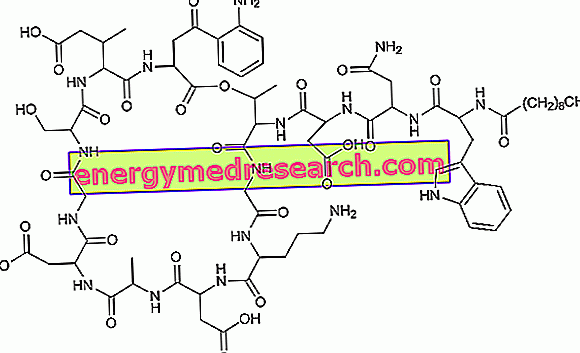Generality
Triglyceridemia is a medical term that describes the presence of triglycerides in the blood . We speak respectively of eutriglyceridemia, hypotriglyceridemia and hypertriglyceridemia, when this value is within the norm, is too low or is too high; then:
- Eutriglyceridemia (or normotriglyceridemia) → triglyceride values are normal;
- Hypertriglyceridemia → triglyceride values are too high;
- Hypiglyceridemia → triglyceride values are too low.
What's this
Triglycerides are fats that circulate in the blood, synthesized by intestinal cells and transported into the bloodstream by lipoproteins (mainly chylomicrons and VLDL, Very Low Density Lipoprotein).
Chylomicrons give triglycerides primarily to muscles, heart and liver to meet the energy needs of these tissues. In high-calorie conditions, however, most of these "vectors" are diverted to fat cells, where fats are stored as a reserve.
Why do you measure
Triglyceridemia is generally measured to assess the patient's cardiovascular risk . High levels of triglycerides in the blood can promote the growth of atherosclerotic plaques and hinder the dissolution of thrombi, increasing the risk of suffering cardiovascular accidents such as heart attack and stroke.
Furthermore, hypertriglyceridemia can cause a state of suffering in the pancreas.

When is the exam prescribed?
Triglyceridemia is performed as a control test, in order to evaluate the patient's lipid metabolism, as the increase in triglycerides is an important risk factor for atherosclerosis and affects heart diseases and diabetes.
Associated with the examination of triglycerides, the doctor can advise you to also perform the determination of closely related parameters, such as total cholesterol, HDL and LDL. If these values are also altered, the risk factors for developing cardiovascular diseases increase.
As part of the lipid profile, triglyceridemia is also indicated in cases where surveillance in dietary regimens is required and can be used to monitor high-risk individuals and those who have had a heart attack or who are being treated for lipids and / or high triglycerides.
Normal values
The reference range for triglyceridemia is 40-170 mg / dl .
High Triglyceridemia - Causes
An increase in triglycerides may be due to multiple situations or diseases, including:
- High calorie diets, rich in saturated fats and cholesterol;
- Excess alcohol consumption;
- Therapies with certain drugs (beta-blockers, estrogens and diuretics);
- Inadequately treated diabetes;
- Genetic factors (familial hyperlipoproteinemia);
- Hepatic cirrhosis;
- Hypothyroidism;
- Pancreatitis;
- Kidney diseases;
- Sedentary and overweight life.
Low Triglyceridemia - Causes
A decrease in triglycerides may be due to the intake of:
- Ascorbic acid;
- salicylates;
- Clofibrati;
- Omega-3 fatty acids.
Furthermore, a low triglyceridemia can be associated with:
- Malnutrition (whether due to poor nutrition or malabsorption);
- Hyperthyroidism;
- Liver dysfunctions.
How to measure it
For the evaluation of triglyceridemia, the patient must undergo a blood test.
Importance of fasting before the exam: diet and triglycerides
Triglyceridemia is evaluated by a specific analysis on a small sample of venous blood.
The sample must be taken in the morning, fasting for at least 12 hours (only water is allowed). The triglycerides, in fact, are synthesized in part by the body and partly taken up with the normal diet. Consequently, if the calorie intake is high, the triglyceride levels also increase; this is true both when food excesses derive directly from fats, and when they come from carbohydrates.
In fact, our body is able to transform the carbohydrates taken in excess of the requirements into triglycerides.
Triglyceridemia and cardiovascular risk | ||
mg / dL | mmol / L | Interpretation |
<150 | <1.7 | Desirable values |
150-199 | 1.7 to 2.2 | Triglyceridemia close to the limit values that delineate the excess |
200-499 | 2.3 to 5.6 | High triglyceridemia |
> 500 | > 5.6 | Very high triglyceridemia |
Preparation
Before taking the sample, remember:
- Remain fasting for at least 12-14 hours (after a meal, triglyceridemia can also increase by 5-10 times compared to the basal values). For the same reason, the evening before the exam takes a light and balanced meal.
- Avoid drinking alcohol two or three days before the test.
- Avoid overeating for at least 4-5 days before the exam.
- Physical activity should also be limited within the 48 hours preceding the test.
Alcohol and certain drugs can alter triglyceridemia. Medications that increase blood triglyceride levels include beta blockers, estrogens, birth control pills, retinoids, cholestyramine, protease inhibitors and certain antipsychotics.
The opposite effect (hypotriglyceridemia) is produced by drugs such as ascorbic acid, fibrates, statins, nicotinic acid and, among supplements, fish oil and dietary fiber (including prebiotics).
Variations can also be caused by the different posture at the time of sampling (the plasma volume can decrease up to 12% passing from the clino- to the orthostatism). This is why it is advisable to stand upright for at least 30 minutes before taking them.
Interpretation of Results
- Hypertriglyceridemia : a higher than normal blood triglyceride value could depend on an unbalanced diet, rich in sugars and fats (such as, for example, butter, oil, salami and meat fat, sweets, etc.). However, the increase in triglyceridemia may also be a sign of more worrying diseases, such as hyperthyroidism.
Some factors contribute to increasing triglyceridemia and the risk of developing cardiovascular diseases, including sedentary life, overweight, smoking, excessive alcohol consumption and conditions such as diabetes and kidney disease.
- Hypiglyceridemia: lower than normal blood triglyceride values may be associated with malnutrition, hyperthyroidism or liver dysfunction.
Causes of high and low triglycerides | |
Causes of hypotriglyceridemia | Causes of hypertriglyceridemia |
|
|



